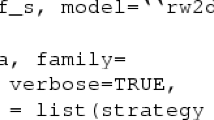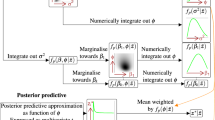Abstract
A probabilistic Bayesian method called weights of evidence (WofE) was used to develop a synthetic dataset of cattle farm locations at a national scale across Australia. The synthetic dataset was required for the modelling of livestock movements with a view to assessing biosecurity implications. The WofE method is based on the analysis of spatial relationships between evidential patterns with respect to an event, such as the actual location of a farm. The evidential patterns of cattle farms were derived from maps of land use, land tenure, drainage systems, roads, settlements and long-term averaged rainfall. These evidential patterns were used for delineating and ranking land areas suitable for cattle farming. For each evidential pattern statistics such as a positive weight, a negative weight and a contrast were calculated for estimating the degree of correlation between the evidential patterns and known farm locations. The integrated evidential patterns of known farms were then used for estimating posterior probabilities and splitting land into five different classes according to its suitability for farming.















Similar content being viewed by others
Notes
Sizes of real cattle farms vary in size and shape. However, for modelling geolocations, neither the size nor shape of cattle farms is taken into account; a farm’s location is presented by a single point which is often situated in the centre of a property or a property block. Bigger farms are separated by longer distances; therefore, cattle properties bigger than 1 km2 will never be associated with the same 1-km2 unit cell from the study region. However, a few farms smaller than 1 km2 could be associated with the same 1-km2 unit cell within the study region. To avoid duplication, the training dataset of farm locations used for modelling purposes only recorded one farm per 1 km2. This ensures that the contribution of any farm from the training dataset into the prior probability will not be overestimated.
The original data and GIS files are available on request by contacting the corresponding author.
References
ABARE (2003). Survey methods and definitions. In: Australian Farm Surveys Report 2003 (pp 30–40). Retrieved from http://www.abareconomics.com/interactive/farm_surveys/pdf/survey_methods.pdf.
Agterberg, F. P. (1989). Systematic approach to dealing with uncertainty of geoscience information in mineral exploration (chapter 18, pp.165–178). In Proceedings of the 21st APCOM Symposium, March 1989, Las Vegas.
Agterberg, F. P., Bonham-Carter, G. F., & Wright, D. F. (1990). Statistical pattern integration for mineral exploration. In G. Gaal & D.F. Merriam (Eds.), Computer Applications in Resource Estimation (pp. 1–21). Oxford: Pergamon.
Alberti, L., De Amicis, M., Masetti, M. & Sterlacchini, S. (2001). Bayes’ rule and GIS for evaluating sensitivity of groundwater to contamination. In: 2001 Annual Conference of the International Association for Mathematical Geology, IAMG 2001, 6–12 September 2001, Mexico. Retrieved 10 February, 2007 from http://www.kgs.ku.edu/Conferences/IAMG/Sessions/F/Papers/sterlanew.pdf.
Aspinall, R. (1992). An inductive modelling procedure based on Bayes’s theorem for analysis of pattern in spatial data. International Journal of Geographical Information Systems, 60(N2), 105–121.
Boleneus, D. E., Raines, G. L., Causey, J. D., Bookstrom, A. A., Frost, T. P., & Hyndman, P. C. (2001). Assessment method for epithermal gold deposits in northeast Washington State using weights-of-evidence GIS modelling. Open-File Report 01-501, US Geological Survey. Retrieved 12 March 2007, from http://pubs.usgs.gov/of/2001/of01-501/of01-501.pdf.
Bonham-Carter, G. F. (1994). Geographic information systems for geoscientists. Oxford: Pergamon.
Bonham-Carter, G. F., & Agterberg, F. P. (1990). Application of a microcomputer-based geographic information system to mineral mapping. In T. Hanley, & D. F. Merriam (Eds.) Microcomputers in geology, version 2. Oxford: Pergamon.
Bonham-Carter, G. F., Agterberg, F. P., & Wright, D. F. (1988). Integration of geological datasets for gold exploration in Nova Scotia. Photometry and Remote Sensing, 54(N11), 1585–1592.
Bonham-Carter, G. F., Agterberg, F. P., & Wright, D. F. (1989). Weights of evidence modelling: A new approach to mapping mineral potential. In F. P. Agterberg & G. F. Bonham-Carter (Eds.), Statistical applications in the earth sciences (pp. 171–183). Canada: Geological Survey of Canada Paper 89-9.
Daneshfar, B., & Benn, K. (2002). Spatial relationships between natural seismicity and faults, south-eastern Ontario and north-central New York state. Tectonophysics, 353, 31–44.
Diggs, D. M. & Brunswig, R. H. (2006). Modeling Native American sacred sites in Rocky Mountain National Park. In: 2006 ESRI International User Conference Proceedings, August 2006, San Diego. Retrieved 10 February 2007, from http://gis.esri.com/library/userconf/proc06/papers/papers/pap_2243.pdf.
Garner, G. M. (2006). Building a national spatially referenced dataset of Australian beef cattle farms. Unpublished Discussion Paper prepared by the Office of the Chief Veterinary Officer, Department of Agriculture, Fisheries and Forestry, Canberra, 16 pp.
Greenhill, D., Ripke, L. T., Hitchman, A. P., Jones, G. A. & Wilkinson, G. G. (2003).Use of Lacunarity index to characterize suburban areas for land use planning using IKONOS-2 Multispectral imagery. In: Second GRSS ISPRSJoint Workshop on Remote Sensing and Data Fusion over Urban Areas, Berlin.
Hutchinson, M. F. (1989). A new objective method for spatial interpolation of meteorological variables from irregular networks applied to the estimation of monthly mean solar radiation, temperature, precipitation and windrun. In: Technical Memorandum 89/5 (pp. 95–104). Canberra Australia: Division of Water Resources, CSIRO.
Knapps, S., Smart, R., & Barodien, G. (2006) National Land Use Maps: 1992/93, 1993/94, 1996/97, 2000/01, 2001/02 Version 3, BRR 44, National Land & Water Resources Audit, Natural Heritage Trust.
Mandelbrot, B. (1983). The fractal geometry of nature. NewYork: Freeman.
Peralta, P., & Mather, P. (2000). An analysis of deforestation patterns in the extractive reserves of Acre, Amazonia from satellite imagery: A landscape ecological approach. International Journal of Remote Sensing, 21(N13&N14), 2555–2570.
Plotnick, R. E., Gardner, R. H., Hargrove, W. W., Prestegaard, K., & Perlmutter, M. (1996). Lacunarity analysis: A general technique for the analysis of spatial patterns. Physical Review E, 53(N5), 5461–5468.
Raines, G. L., & Mihalasky, M. J. (2002). A reconnaissance method for delineation of tracts for regional-scale mineral-resource assessment based on geologic-map data. Natural Resources Research, 11(4), 241–248.
Sawatzky, D. L., Raines, G. L., Bonham-Carter, G. F., & Looney, C. G. (2004). ARCSDM3.1: ArcMAP extension for spatial data modelling using weights of evidence, logistic regression, fuzzy logic and neural network analysis. Retrieved from http://www.ige.unicamp.br/sdm/ArcSDM31/.
Sere, C., & Steinfeld, H. (1995). World livestock production systems: Current status, issues and trends. In: FAO Animal Health and Production Paper 127 (p. 92). Rome: Food and Agriculture Organization of the United Nations.
Spiegelhalter, D. J. (1986). Uncertainty in expert systems. In W. A. Gale (Ed.), Artificial intelligence and statistics (pp. 17–55). Reading: Addison-Wesley.
Tangestani, M. H., & Moore, F. (2001). Porphyry copper potential mapping using the weights-of-evidence model in a GIS, northern Shahr-e-Babak, Iran. Australian Journal of Earth Sciences, 48, 695–701.
Zahiri, H., Palamara, D. R., Flentje, P., Brassington, G. M., & Baafi, E. (2006). A GIS-based weights-of-evidence model for mapping cliff instabilities associated with mine subsidence. Environmental Geology, 51, 377–386.
Acknowledgements
Thanks to John Roberts of the Primary Industries & Fisheries, Queensland, Australia and Chris Ryan of the Rural Land Protection Board State Council, New South Wales, Australia for the provision of the validation datasets.
Author information
Authors and Affiliations
Corresponding author
Rights and permissions
About this article
Cite this article
Emelyanova, I.V., Donald, G.E., Miron, D.J. et al. Probabilistic Modelling of Cattle Farm Distribution in Australia. Environ Model Assess 14, 449–465 (2009). https://doi.org/10.1007/s10666-008-9140-z
Received:
Accepted:
Published:
Issue Date:
DOI: https://doi.org/10.1007/s10666-008-9140-z




